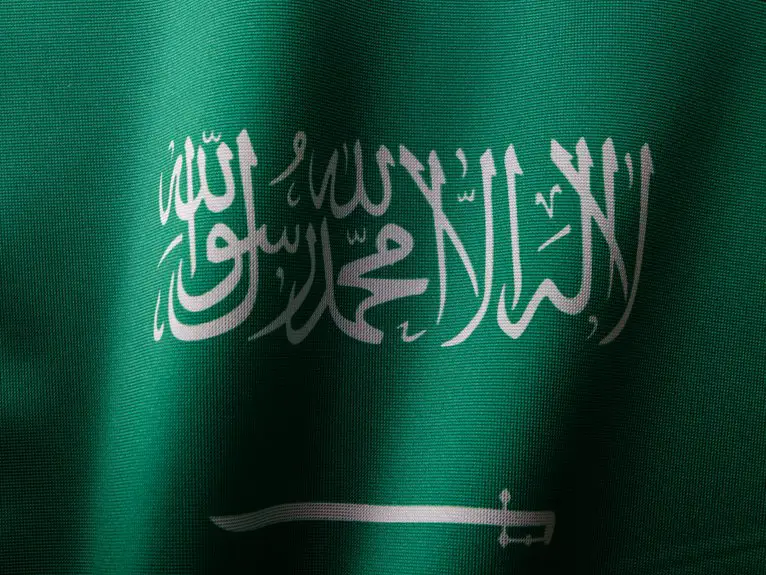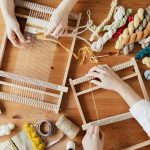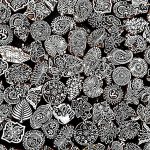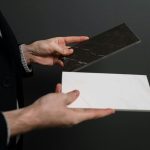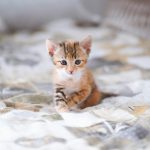If you explore 1800s calico fabric, you’ll find sturdy cotton with muted floral and geometric prints. You’d spot tiny flowers and simple shapes in earthy tones like indigo blues and rusty reds. Makers used early power looms and hand-block printing to create vibrant, affordable patterns that were both functional and stylish. Calico wasn’t just fabric; it shaped daily life and culture. Keep going, and you’ll uncover more about its rich history and impact.
Table of Contents
Key Takeaways
- Calico fabric in the 1800s featured small floral motifs and geometric patterns like dots, stripes, and checks in muted, earthy tones.
- Production used hand-operated spinning wheels and early power looms with wooden block or copper roller printing methods.
- Natural plant and mineral dyes created vibrant indigo blues, rusty reds, and other earthy colors on calico fabric.
- Slight irregularities from hand-block printing gave calico a unique, handcrafted appearance.
- Calico combined affordability with fashionable appeal, commonly used for dresses, aprons, curtains, and quilts.
Origins of Calico Fabric
Although calico fabric is commonly associated with quaint patterns, its origins trace back to ancient India, where artisans first crafted this durable cotton cloth.
Calico fabric, often linked to charming patterns, actually began as a sturdy cotton cloth crafted in ancient India.
When you explore calico’s beginnings, you’ll find it was named after the city of Calicut, a major trading port. You can imagine skilled weavers producing plain-woven cotton that was sturdy yet breathable, perfect for everyday wear in warm climates.
Merchants quickly recognized calico’s value and exported it widely, spreading this versatile fabric across continents.
You’ll notice that early calico wasn’t just utilitarian; it sometimes featured simple printed designs using natural dyes.
Calico Production Techniques in the 1800s
By the 1800s, calico had grown from its humble origins into a fabric in high demand across Europe and America.
You’d see calico made primarily with hand-operated spinning wheels and early power looms, speeding up cotton thread production.
After weaving, calico was usually left plain or printed with designs using wooden block printing or copper rollers.
You’d find artisans carefully applying natural dyes extracted from plants and minerals, ensuring vibrant, long-lasting colors.
The introduction of roller printing revolutionized the process by allowing continuous patterns to be applied quickly and with more detail.
You could also spot calico undergoing bleaching to achieve a brighter white base before printing.
These production techniques combined tradition with emerging industrial advances, making calico both affordable and widely available during the 19th century.
Common Patterns and Color Schemes
When you look at calico fabric, you’ll notice its charm often comes from the simple yet striking patterns and color schemes used. These designs were practical but also visually appealing, reflecting the tastes of the 1800s.
- Floral motifs dominated, featuring small, delicate flowers in repeating patterns.
- Geometric shapes like dots, stripes, and checks added structure and variety.
- Color palettes were typically muted, with earthy tones such as indigo blues, rusty reds, and soft browns.
- Hand-block printing created slight irregularities, giving each piece a unique character.
These elements combined to make calico both affordable and fashionable, allowing you to enjoy timeless fabric that balanced simplicity with charm perfectly.
Uses of Calico in 19th Century Daily Life
Calico fabric played a significant role in 19th century daily life, serving many practical purposes in homes and wardrobes. You’d find calico in everything from clothing to household items due to its affordability and durability. It was especially popular for dresses, aprons, and children’s wear. In homes, calico covered furniture, made curtains, and served as bedding fabric. Its simple yet sturdy nature made it ideal for everyday use, blending function with a touch of style. Here’s a quick look at common uses:
| Clothing | Household Items | Accessories |
|---|---|---|
| Dresses | Curtains | Handkerchiefs |
| Aprons | Quilts | Pouches |
| Children’s wear | Tablecloths | Bags |
| Work shirts | Cushion covers | Caps |
You’d rely on calico for many daily needs, thanks to its versatility.
The Cultural Impact of Calico in Europe and America
Although often overlooked today, calico shaped cultural trends across Europe and America in profound ways.
You’d find calico fabric influencing fashion, economy, and social identity in the 1800s. When you explore its impact, consider these key points:
- Calico’s affordability made patterned clothing accessible to working-class families, changing fashion norms.
- You’d see calico used in quilts and home décor, symbolizing comfort and domestic creativity.
- Trade restrictions on calico imports sparked political debates, affecting economic policies.
- Calico prints inspired artists and designers, influencing visual culture beyond textiles.
Frequently Asked Questions
How Is Calico Fabric Cared for and Cleaned Today?
You might think calico’s delicate, but you can actually toss it in the wash on a gentle cycle. Just avoid bleach and hot water, and you’ll keep that charming pattern looking fresh and vibrant every time.
Are Modern Calico Fabrics Similar to 1800S Calico?
You’ll find modern calico fabrics share the same lightweight, plain-woven cotton feel as 1800s calico, but today’s prints and finishes are more vibrant and durable thanks to advanced dyeing and manufacturing techniques.
What Are the Environmental Impacts of Calico Production?
Calico production can impact the environment like a storm, using lots of water and chemicals. You’ll want to choose eco-friendly options, as traditional dyeing and cotton farming can lead to pollution and resource depletion if you’re not careful.
Can Calico Fabric Be Used for Upholstery or Heavy-Duty Items?
You can use calico for upholstery or heavy-duty items, but it’s best to choose a tightly woven, heavier weight version. Otherwise, it may wear out quickly under heavy use or frequent friction.
How Does Calico Compare to Other Cotton Fabrics Like Muslin?
You know what they say, “Don’t judge a book by its cover.” Calico’s coarser and sturdier than muslin, which feels lighter and softer. You’ll find calico better for durable projects, while muslin suits delicate uses.
- Nui Shibori: The Stitched Resist Dyeing Technique - July 13, 2025
- Kumo Shibori: The Pleat and Bind Resist Technique - July 13, 2025
- Itajime Shibori: The Fold and Clamp Dyeing Technique - July 13, 2025

